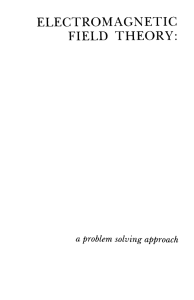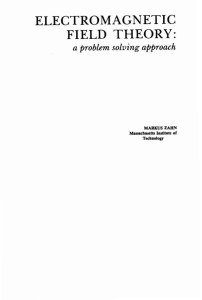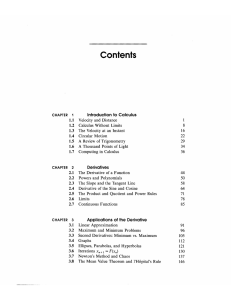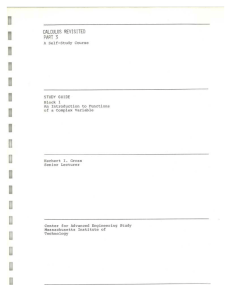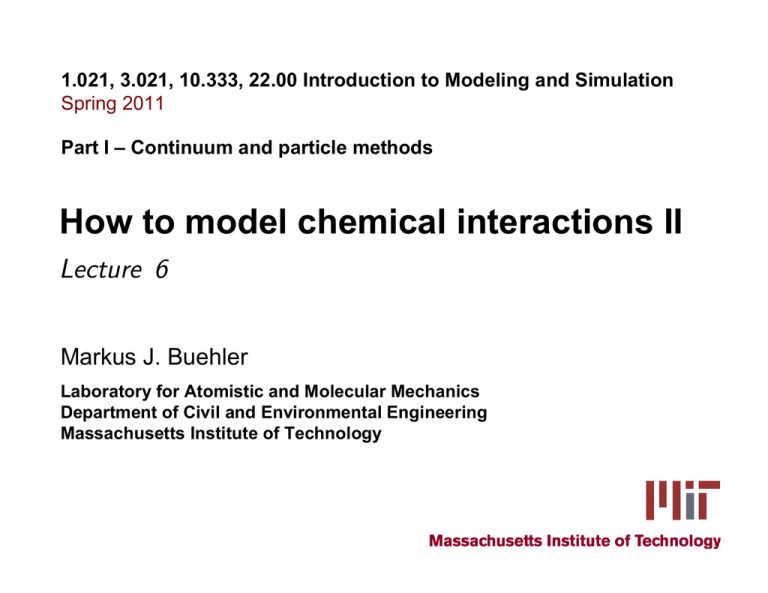
1.021, 3.021, 10.333, 22.00 Introduction to Modeling and Simulation
Spring 2011
Part I – Continuum and particle methods
How to model chemical interactions II
Lecture 6
Markus J. Buehler
Laboratory for Atomistic and Molecular Mechanics
Department of Civil and Environmental Engineering
Massachusetts Institute of Technology
1
Content overview
I. Particle and continuum methods
1.
2.
3.
4.
5.
6.
7.
8.
Atoms, molecules, chemistry
Continuum modeling approaches and solution approaches
Statistical mechanics
Molecular dynamics, Monte Carlo
Visualization and data analysis
Mechanical properties – application: how things fail (and
how to prevent it)
Multi-scale modeling paradigm
Biological systems (simulation in biophysics) – how
proteins work and how to model them
II. Quantum mechanical methods
1.
2.
3.
4.
5.
6.
7.
8.
Lectures 2-13
Lectures 14-26
It’s A Quantum World: The Theory of Quantum Mechanics
Quantum Mechanics: Practice Makes Perfect
The Many-Body Problem: From Many-Body to SingleParticle
Quantum modeling of materials
From Atoms to Solids
Basic properties of materials
Advanced properties of materials
What else can we do?
2
Overview: Material covered so far…
Lecture 1: Broad introduction to IM/S
Lecture 2: Introduction to atomistic and continuum modeling
(multi-scale modeling paradigm, difference between continuum and
atomistic approach, case study: diffusion)
Lecture 3: Basic statistical mechanics – property calculation I
(property calculation: microscopic states vs. macroscopic
properties, ensembles, probability density and partition function)
Lecture 4: Property calculation II (Monte Carlo, advanced
property calculation, introduction to chemical interactions)
Lecture 5: How to model chemical interactions I (example:
movie of copper deformation/dislocations, etc.)
Lecture 6: How to model chemical interactions II
3
Lecture 6: How to model chemical interactions II
Outline:
1. Case study: Deformation of copper wire (cont’d)
2. How to model metals: Multi-body potentials
3. Brittle versus ductile materials
4. Basic deformation mechanism in brittle materials - crack extension
Goal of today’s lecture:
Complete example of copper deformation
Learn how to build a model to describe brittle fracture (from scratch)
Learn basics in fracture of brittle materials
Apply our tools to model a particular material phenomena – brittle
fracture (useful for pset #2)
4
1. Case study: Deformation of copper wire
(cont’d)
5
A simulation with 1,000,000,000 particles
Lennard-Jones - copper
Fig. 1 c from Buehler, M., et al. "The Dynamical Complexity of Work-Hardening: A Large-Scale
Molecular Dynamics Simulation." Acta Mech Sinica 21 (2005): 103-11.
© Springer-Verlag. All rights reserved. This content is excluded from our Creative Commons
license. For more information, see http://ocw.mit.edu/fairuse.
6
??
Image by MIT OpenCourseWare.
Strengthening caused by hindering
dislocation motion
If too difficult, ductile modes break
down and material becomes brittle
7
Fig. 1 c from Buehler, M. et al. "The Dynamical Complexity of WorkHardening: A Large-Scale Molecular Dynamics Simulation." Acta Mech Sinica
21 (2005): 103-111.
© Springer-Verlag. All rights reserved. This content is excluded from our
Creative Commons license. For more information, see
http://ocw.mit.edu/fairuse.
8
Parameters for Morse potential
(for reference)
9
Morse potential parameters for various metals
Morse Potential Parameters for 16 Metals
Metal
αa0
β
L x 10-22 (eV)
α (Α−1)
r0 (Α)
D (eV)
Pb
2.921
83.02
7.073
1.1836
3.733
0.2348
Ag
2.788
71.17
10.012
1.3690
3.115
0.3323
Ni
2.500
51.78
12.667
1.4199
2.780
0.4205
Cu
2.450
49.11
10.330
1.3588
2.866
0.3429
Al
2.347
44.17
8.144
1.1646
3.253
0.2703
Ca
2.238
39.63
4.888
0.80535
4.569
0.1623
Sr
Mo
2.238
2.368
39.63
88.91
4.557
24.197
0.73776
1.5079
4.988
2.976
0.1513
0.8032
W
2.225
72.19
29.843
1.4116
3.032
0.9906
Cr
2.260
75.92
13.297
1.5721
2.754
0.4414
Fe
1.988
51.97
12.573
1.3885
2.845
0.4174
Ba
1.650
34.12
4.266
0.65698
5.373
0.1416
K
1.293
23.80
1.634
0.49767
6.369
0.05424
Na
1.267
23.28
1.908
0.58993
5.336
0.06334
Cs
Rb
1.260
1.206
23.14
22.15
1.351
1.399
0.41569
0.42981
7.557
7.207
0.04485
0.04644
Adapted from Table I in Girifalco, L. A., and V. G. Weizer. "Application of the Morse Potential Function
to Cubic Metals." Physical Review 114 (May 1, 1959): 687-690.
Image by MIT OpenCourseWare.
φ ( rij ) = D exp(− 2α ( rij − r0 ) ) − 2 D exp(− α ( rij − r0 ) )
10
Morse potential: application example (nanowire)
See: Komanduri, R., et al. "Molecular Dynamics (MD) Simulation of Uniaxial Tension of Some Single-Crystal
Cubic Metals at Nanolevel." International Journal of Mechanical Sciences 43, no. 10 (2001): 2237-60.
Further Morse potential parameters:
Courtesy of Elsevier, Inc., http://www.sciencedirect.com. Used with permission.
11
Cutoff-radius: saving time
12
Cutoff radius
N
U i = ∑ φ ( rij )
j =1
6
…
i
j=1
Ui =
5
4
∑φ (r )
j =1.. N neigh
φ
~σ
2
ij
LJ 12:6
potential
3
rcut
ε0
rcut
Cutoff radius = considering interactions only to a certain distance
Basis: Force contribution negligible (slope)
r
13
Derivative of LJ potential ~ force
rcut
0.1
ο
-dφ/dr (eV/A)
0.2
dφ(r)
F = _ _____
dr
0
Potential shift
-0.1
-0.2
2
r0
3
4
5
o
r (A)
Image by MIT OpenCourseWare.
Beyond cutoff: Changes in energy (and thus forces) small 14
Putting it all together…
15
MD updating scheme: Complete
(1) Updating method (integration scheme)
2
ri (t0 + Δt ) = −ri (t0 − Δt ) + 2ri (t0 )Δt + ai (t0 )(Δt ) + ...
Positions
at t0-Δt
Positions
at t0
Accelerations
at t0
(2) Obtain accelerations from forces
f i = mai
ai = f i / m
(4) Crystal (initial conditions)
Positions at t0
(3) Obtain forces from potential
d φ (r)
F =−
dr
Potential
xi
fi = F
r
⎛ ⎡ σ ⎤12 ⎡ σ ⎤ 6 ⎞
φ ( r ) = 4ε ⎜⎜ ⎢ ⎥ − ⎢ ⎥ ⎟⎟
⎣r⎦ ⎠
⎝⎣ r ⎦
16
2.2 How to model metals: Multi-body
potentials
Pair potential: Total energy
sum of all pairs of bonds
Individual bond contribution
does not depend on other atoms
“all bonds are the same”
Courtesy of the Center for Polymer
Studies at Boston University. Used
with permission.
Is this a good assumption?
U total =
N
1
2
N
∑ ∑φ (r )
i =1,i ≠ j j =1
ij
17
Are all bonds the same? - valency in hydrocarbons
Ethane C2H6
(stable configuration)
All bonds are not the same!
Adding another H is not favored
H
18
Are all bonds the same? – metallic systems
stronger
+ different
bond EQ
distance
Surface
Bulk
Pair potentials: All bonds are equal!
Reality: Have environment
effects; it matter that there is a
free surface!
Bonds depend on the environment!
19
Are all bonds the same?
Bonding energy of red atom in
is six times bonding energy in
This is in contradiction with both experiments and more accurate quantum
mechanical calculations on many materials
N
Bonding energy of atom i
U i = ∑ φ ( rij )
j =1
6
U i = ∑ φ ( rij )
j =1
U i = φ ( rij )
20
After: G. Ceder
Are all bonds the same?
Bonding energy of red atom in
is six times bonding energy in
This is in contradiction with both experiments and more accurate quantum
mechanical calculations on many materials
For pair potentials
For metals
~Z
Z:
Coordination = how many
immediate neighbors an atom has
~ Z
Bonds get “weaker” as more atoms are added to central atom
21
After: G. Ceder
Bond strength depends on coordination
energy per bond
~ Z pair potential
~ Z
Nickel
2
4
6
8
10 12
Z
coordination
22
Daw, Foiles, Baskes, Mat. Science Reports, 1993
Transferability of pair potentials
Pair potentials have limited transferability:
Parameters determined for molecules can not be used
for crystals, parameters for specific types of crystals can
not be used to describe range of crystal structures
E.g. difference between FCC and BCC can not be
captured using a pair potential
23
Metallic bonding: multi-body effects
Need to consider more details of chemical bonding to
understand environmental effects
Electron (q=-1)
+
Ion core (q=+N)
+ + + + + +
+ + + + + +
+ + + + + +
Delocalized valence electrons moving between nuclei generate a
binding force to hold the atoms together: Electron gas model
(positive ions in a sea of electrons)
Mostly non-directional bonding, but the bond strength indeed
depends on the environment of an atom, precisely the electron
density imposed by other atoms
24
Concept: include electron density effects
πρ
π ρ, j
Each atom features a particular distribution of electron density
25
Concept: include electron density effects
ρi =
Electron density
at atom i
∑π ρ
j =1.. N neigh
,j
( rij )
rij = x j − xi
rij
j
Atomic electron
density contribution
of atom j to atom i
i
π ρ , j ( rij )
Contribution to electron density at site i due to electron
density of atom j evaluated at distance rij
26
Concept: include electron density effects
1
φi =
2
∑φ (r ) + F ( ρ )
j =1.. N neigh
Electron density at atom i
ρi =
π ρ , j ( rij )
j
xj
i
xi
ij
∑π ρ
j =1.. N neigh
i
embedding term F (how local
electron density contributes to
potential energy)
,j
( rij )
rij = x j − xi
Atomic electron
density contribution
of atom j to atom i27
Embedded-atom method (EAM)
Atomic energy
1
φi =
2
Total energy
new
∑φ (r ) + F ( ρ )
j =1.. N neigh
ij
Pair potential energy
ρi
i
N
U total = ∑ φi
i =1
Embedding energy
as a function of electron
density
Electron density at atom i
based on a “pair potential”:
ρi =
∑π ρ
j =1.. N neigh
,j
( rij )
First proposed by Finnis, Sinclair, Daw, Baskes et al. (1980s)
28
Embedding term: example
0
G (eV)
Embedding energy
-5
-10
0
0.01
0.02
0.03
0.04
0.05
0.06
ρ (A-3)
o
Image by MIT OpenCourseWare.
⎛1
⎞
φi = ∑ ⎜ φ ( rij ) + F ( ρ i ) ⎟
⎠
j =1.. N neigh ⎝ 2
Pair potential
energy
Electron density
Embedding energy
as a function of electron density
29
Pair potential term: example
2
Pair contribution
φ ( rij )
U (eV)
1.5
1
0.5
0
2
3
4
o
R (A)
⎛1
⎞
φi = ∑ ⎜ φ ( rij ) + F ( ρ i ) ⎟
⎠
j =1.. N neigh ⎝ 2
Pair potential
energy
Image by MIT OpenCourseWare.
Distance
Embedding energy
as a function of electron density
rij
30
Effective pair interactions
r
Effective pair potential (eV )
1
++++++
++++++
++++++
Bulk
0.5
Surface
r
0
-0.5
2
3
4
o
r (A)
Image by MIT OpenCourseWare.
++++++
++++++
++++++
Can describe differences between bulk and surface
31
See also: Daw, Foiles, Baskes, Mat. Science Reports, 1993
Comparison with experiment
32
Diffusion: Activation energies
(in eV)
Courtesy of Elsevier, Inc., http://www.sciencedirect.com. Used with permission.
33
Comparison EAM model vs. experiment
Melting temperature (in K)
34
Summary: EAM method
State of the art approach to model metals
Very good potentials available for Ni, Cu, Al since late
1990s, 2000s
Numerically efficient, can treat billions of particles
Not much more expensive than pair potential
(approximately three times), but describes physics much
better
Strongly recommended for use!
35
3. Brittle versus ductile materials
36
Tensile test of a wire
Brittle
Stress
Ductile
Necking
Strain
Image by MIT OpenCourseWare.
Brittle
Ductile
Image by MIT OpenCourseWare.
37
Ductile versus brittle materials
BRITTLE
Glass Polymers
Ice...
DUCTILE
Copper, Gold
Shear load
Difficult
to deform,
breaks easily
Image by MIT OpenCourseWare.
Easy to deform
hard to break
43
38
Deformation of materials:
Nothing is perfect, and flaws or cracks matter
Failure of materials initiates at cracks
Griffith, Irwine and others: Failure initiates at defects, such as cracks, or
grain boundaries with reduced traction, nano-voids, other imperfections 39
SEM picture of material: nothing is perfect
40
Significance of material flaws
“global”
“local”
Fig. 1.3 in Buehler, Markus J. Atomistic Modeling of Materials Failure. Springer, 2008. © Springer. All rights reserved. This
content is excluded from our Creative Commons license. For more information, see http://ocw.mit.edu/fairuse.
Stress concentrators: local stress >> global stress
41
Deformation of materials:
Nothing is perfect, and flaws or cracks matter
“Micro (nano), local”
“Macro,
global”
σ (r )
r
Failure of materials initiates at cracks
Griffith, Irwine and others: Failure initiates at defects, such as cracks, or
grain boundaries with reduced traction, nano-voids, other imperfections 42
Cracks feature a singular stress field, with
singularity at the tip of the crack
stress tensor
1
σ (r) ~
r
y
σyy
σxx
σxy
σrθ
σrr
σθθ
r
θ
x
Image by MIT OpenCourseWare.
K I : Stress intensity factor (function of geometry)
43
Crack extension: brittle response
σ (r )
r
Large stresses lead to
rupture of chemical
bonds between atoms
Thus, crack extends
44
Image by MIT OpenCourseWare.
Lattice shearing: ductile response
Instead of crack extension,
induce shearing of atomic lattice
Due to large shear stresses at
crack tip
Lecture 5
Image by MIT OpenCourseWare.
τ
τ
τ
τ
Image by MIT OpenCourseWare.
45
Brittle vs. ductile material behavior
Whether a material is ductile or brittle depends on the material’s
propensity to undergo shear at the crack tip, or to break atomic
bonds that leads to crack extension
Intimately linked to the atomic structure and atomic bonding
Related to temperature (activated process); some mechanism are
easier accessible under higher/lower temperature
Many materials show a propensity towards brittleness at low
temperature
Molecular dynamics is a quite suitable tool to study these
mechanisms, that is, to find out what makes materials brittle or
ductile
46
Historical example: significance of brittle vs.
ductile fracture
Liberty ships: cargo ships built in the U.S. during World War II (during
1930s and 40s)
Eighteen U.S. shipyards built 2,751 Liberties between 1941 and 1945
Early Liberty ships suffered hull and deck cracks, and several were lost
to such structural defects
Twelve ships, including three of the 2710 Liberties built, broke in half
without warning, including the SS John P. Gaines (sank 24 November
1943)
Constance Tipper of Cambridge University demonstrated that the
fractures were initiated by the grade of steel used which suffered from
embrittlement.
She discovered that the ships in the North Atlantic were exposed to
temperatures that could fall below a critical point when the mechanism
of failure changed from ductile to brittle, and thus the hull could
fracture relatively easily.
47
Liberty ships: brittle failure
Courtesy of the U.S. Navy.
48
4. Basic deformation mechanism in brittle
materials - crack extension
49
Introduction: brittle fracture
Materials: glass, silicon, many ceramics, rocks
At large loads, rather than accommodating a shape change,
materials break
Image courtesy of quinn.anya.
License: CC-BY.
50
Science of fracture: model geometry
Typically consider a single crack in a crystal
Remotely applied mechanical load
Following discussion focused on single cracks and their behavior
remote load
a
remote load
51
Image by MIT OpenCourseWare.
Brittle fracture loading conditions
Commonly consider a single crack in a material geometry, under
three types of loading: mode I, mode II and mode III
Mode I
Mode II
Mode III
Tensile load, focus of this lecture
Image by MIT OpenCourseWare.
Tensile load, focus
of this lecture
52
Brittle fracture mechanisms: fracture is a multiscale phenomenon, from nano to macro
Image removed due to copyright restrictions. See Fig. 6.2 in Buehler, Markus J.
Atomistic Modeling of Materials Failure. Springer, 2008.
53
Focus of this part
Basic fracture process: dissipation of elastic energy
Fracture initiation, that is, at what applied load to fractures initiate
Fracture dynamics, that is, how fast can fracture propagate in
material
54
Basic fracture process: dissipation of elastic energy
δa
Undeformed
Stretching=store elastic energy
Release elastic energy
dissipated into breaking
55
chemical bonds
Elasticity = reversible deformation
cross-sectional
area
A
Stress?
Force per unit area
56
Elasticity = reversible deformation
cross-sectional
area
A
σ =F/A
Stress?
Force per unit area
57
Elasticity = reversible deformation
cross-sectional
area
σ =F/A
A
area under
curve: stored
energy
σ = Eε
ε = Δu / L
58
Young’s modulus
Continuum description of fracture
Fracture is a dissipative process in which elastic energy is dissipated to
break bonds (and to heat at large crack speeds)
Energy to break bonds = surface energy γs (energy necessary to create new
surface, dimensions: energy/area, Nm/m2)
"Relaxed"
element
σ
"Strained"
element
a~
δa
ξ
a~
a
(2)
σ
(1)
Image by MIT OpenCourseWare.
59
Continuum description of fracture
Fracture is a dissipative process in which elastic energy is dissipated to
break bonds (and to heat at large crack speeds)
Energy to break bonds = surface energy γs (energy necessary to create new
surface, dimensions: energy/area, Nm/m2)
"Relaxed"
element
σ
"Strained"
element
σ
a~
δa
1 σ2
2 E
a
σ
(2)
WP (1) =
1σ
1σ ~
V=
ξa B
2 E
2 E
WP ( 2) = 0
2
ε
ξ
a~
(1)
Image by MIT OpenCourseWare.
2
B out-of-plane thickness
60
Continuum description of fracture
Fracture is a dissipative process in which elastic energy is dissipated to
break bonds (and to heat at large crack speeds)
Energy to break bonds = surface energy γs (energy necessary to create new
surface, dimensions: energy/area, Nm/m2)
"Relaxed"
element
σ
"Strained"
element
σ
a~
δa
1 σ2
2 E
a
σ
(2)
WP (1) =
1σ
1σ ~
V=
ξa B
2 E
2 E
WP ( 2) = 0
2
2
ε
ξ
a~
(1)
Image by MIT OpenCourseWare.
1 σ2 ~
WP ( 2) − WP (1) =
ξa B
2 E
change of elastic (potential) energy
61
Continuum description of fracture
Fracture is a dissipative process in which elastic energy is dissipated to
break bonds (and to heat at large crack speeds)
Energy to break bonds = surface energy γs (energy necessary to create new
surface, dimensions: energy/area, Nm/m2)
"Relaxed"
element
σ
"Strained"
element
σ
a~
δa
ε
ξ
a~
1 σ2
2 E
a
σ
(2)
WP (1) =
1σ
1σ ~
V=
ξa B
2 E
2 E
WP ( 2) = 0
2
2
(1)
Image by MIT OpenCourseWare.
energy to create
surfaces
1 σ2 ~ !
WP (2) − WP (1) =
ξa B = 2γ s a~B
2 E
change of elastic (potential) energy
62
Continuum description of fracture
Fracture is a dissipative process in which elastic energy is dissipated to
break bonds (and to heat at large crack speeds)
Energy to break bonds = surface energy γs (energy necessary to create new
surface, dimensions: energy/area, Nm/m2)
"Relaxed"
element
σ
"Strained"
element
σ
a~
δa
ε
ξ
a~
1 σ2
2 E
a
σ
(2)
WP (1) =
1σ
1σ ~
V=
ξa B
2 E
2 E
WP ( 2) = 0
2
2
(1)
Image by MIT OpenCourseWare.
energy to create
surfaces
1 σ2 ~ !
WP (2) − WP (1) =
ξa B = 2γ s a~B
2 E
change of elastic (potential) energy
σ=
4γ s E
ξ
63
Continuum description of fracture
Fracture is a dissipative process in which elastic energy is dissipated to
break bonds (and to heat at large crack speeds)
Energy to break bonds = surface energy γs (energy necessary to create new
surface, dimensions: energy/area, Nm/m2)
"Relaxed"
element
"Strained"
element
σ
σ
a~
δa
ε
ξ
a~
1 σ2
2 E
a
(2)
σ
(1)
Image by MIT OpenCourseWare.
!
1 σ2 ~
=
ξa B = 2γ s Ba~
2 E
change of elastic
(potential) energy = G
energy to create
surfaces
σ=
4γ s E
ξ
64
Griffith condition for fracture initiation
Energy release rate G, that is, the elastic energy released per unit
crack advance must be equal or larger than the energy necessary to
create new surfaces
1 σ2
G :=
ξ = 2 ys
2 E
Provides criterion to predict failure initiation
Calculation of G can be complex, but straightforward for thin strips
as shown above
Approach to calculate G based on “stress intensity factor” (see
further literature, e.g. Broberg, Anderson, Freund, Tada)
65
Brittle fracture mechanisms
Once nucleated, cracks in brittle materials spread rapidly, on the
order of sound speeds
Sound speeds in materials (=wave speeds):
Rayleigh-wave speed cR (speed of surface waves)
shear wave speed cs (speed of shear waves)
longitudinal wave speed cl (speed of longitudinal waves)
Maximum speeds of cracks is given by sound speeds,
depending on mode of loading (mode I, II, III)
Linear elastic continuum theory
66
Sound speeds in materials: overview
Wave speeds are calculated based on elastic properties of material
μ = shear modulus
E = 8 / 3μ
μ = 3 / 8E
67
Limiting speeds of cracks: linear elastic
continuum theory
Mother-daughter mechanism
SuperSub-Rayleigh Rayleigh
Intersonic
Supersonic
Mode II
Mode I
Cr
Cs
Subsonic
Cl
Limiting speed v
Supersonic
Mode III
Cs
Linear
Cl
Limiting speed v
Nonlinear
Image by MIT OpenCourseWare.
• Cracks can not exceed the limiting speed given by the corresponding
wave speeds unless material behavior is nonlinear
• Cracks that exceed limiting speed would produce energy (physically
impossible - linear elastic continuum theory)
68
Physical reason for crack limiting speed
Physical (mathematical) reason for the limiting speed is that it becomes
increasingly difficult to increase the speed of the crack by adding a larger
load
When the crack approaches the limiting speed, the resistance to
fracture diverges to infinity (=dynamic fracture toughness)
Image removed due to copyright restrictions.
Please see: Fig. 6.15 in Buehler, Markus J. Atomistic Modeling of Materials Failure. Springer, 2008.
69
he
ea
rt
Lin
Stiff
Stress
enin
g
or
y
Linear versus nonlinear elasticity=hyperelasticity
ning
Softe
Hyperelasticity
Strain
Image by MIT OpenCourseWare.
Linear elasticity: Young’s modulus (stiffness) does not change
with deformation
Nonlinear elasticity = hyperelasticity: Young’s modulus (stiffness)
changes with deformation
70
Subsonic and supersonic fracture
Under certain conditions, material nonlinearities (that is, the
behavior of materials under large deformation = hyperelasticity)
becomes important
This can lead to different limiting speeds
than described by the model introduced above
1
σ (r) ~
r
Stress
large deformation
nonlinear zone
“singularity”
cla Line
ss ar
ica e
l t las
he tic
or
ie
s
Deformation field near a crack
N
on
m line
at a
er r r
ia ea
ls l
Strain
small deformation
Image by MIT OpenCourseWare.
71
Limiting speeds of cracks
Image by MIT OpenCourseWare.
• Under presence of hyperelastic effects, cracks can exceed the
conventional barrier given by the wave speeds
• This is a “local” effect due to enhancement of energy flux
72
• Subsonic fracture due to local softening, that is, reduction of energy flux
Stiffening vs. softening behavior
he
“linear elasticity”
ea
rt
Lin
Stiff
Stress
enin
g
or
y
real
materials
σ
ning
Softe
ε
Hyperelasticity
1 σ2
2 E
Strain
Image by MIT OpenCourseWare.
Increased/decreased wave speed
73
Energy flux reduction/enhancement
Classical
New
K dominance zone
Characteristic energy length
Hyperelastic zone
Fracture process zone
Energy Flux Related to Wave Speed: High local wave
speed, high energy flux, crack can move faster (and reverse
for low local wave speed).
Image by MIT OpenCourseWare.
Energy flux related to wave speed: high local wave speed, high energy flux,
crack can move faster (and reverse for low local wave speed)
74
Physical basis for subsonic/supersonic fracture
Changes in energy flow at the crack tip due to changes in local wave
speed (energy flux higher in materials with higher wave speed)
Controlled by a characteristic length scale χ
Reprinted by permission from Macmillan Publishers Ltd: Nature.
Source: Buehler, M., F. Abraham, and H. Gao. "Hyperelasticity Governs Dynamic
Fracture at a Critical Length Scale." Nature 426 (2003): 141-6. © 2003.
75
Summary: atomistic mechanisms of brittle
fracture
Brittle fracture – rapid spreading of a small initial crack
Cracks initiate based on Griffith condition G = 2γs
Cracks spread on the order of sound speeds (km/sec for many
brittle materials)
Cracks have a maximum speed, which is given by characteristic
sound speeds for different loading conditions)
Maximum speed can be altered if material is strongly nonlinear,
leading to supersonic or subsonic fracture
76
Supersonic fracture: mode II (shear)
77
Please see: Buehler, Markus J., Farid F. Abraham, and Huajian Gao. "Hyperelasticity Governs Dynamic Fracture at a Critical Length Scale."
Nature 426 (November 13, 2003): 141-146.
Appendix: Notes for pset #1
78
Notes regarding pset #1 (question 1.)
⎛ Eb ⎞
⎟⎟
D = D0 exp⎜⎜ −
⎝ k BT ⎠
ln(D )
slope
ln( D0 )
Eb
~−
kB
Eb
ln( D ) = ln( D0 ) −
k BT
high temperature
Plot data extracted from RMSD graph, then fit equation
above and identify parameters
low temperature
1
T
79
Mechanism and energy barrier
⎛ Eb ⎞
⎟⎟
D = D0 exp⎜⎜ −
⎝ k BT ⎠
D0 : Rate of attempt
“transition state”
Courtesy of Runningamok19. License: CC-BY.
Eb
80
MIT OpenCourseWare
http://ocw.mit.edu
3.021J / 1.021J / 10.333J / 18.361J / 22.00J Introduction to Modeling and Simulation
Spring 2012
For information about citing these materials or our Terms of use, visit http://ocw.mit.edu/terms.


